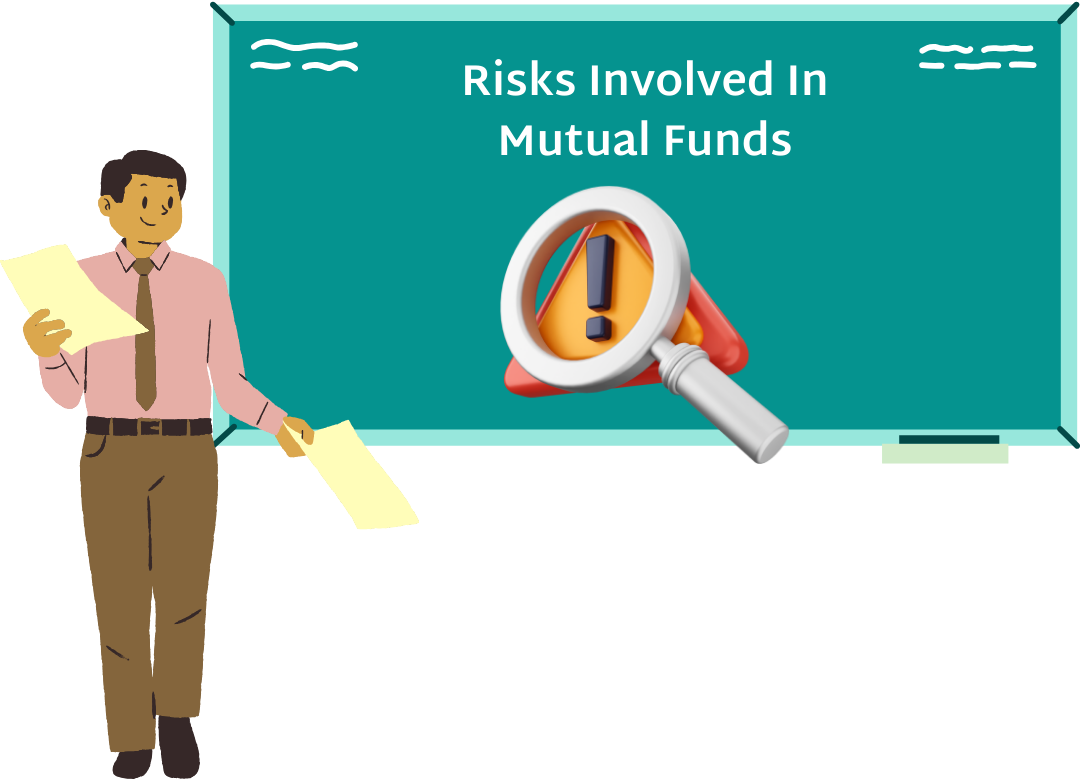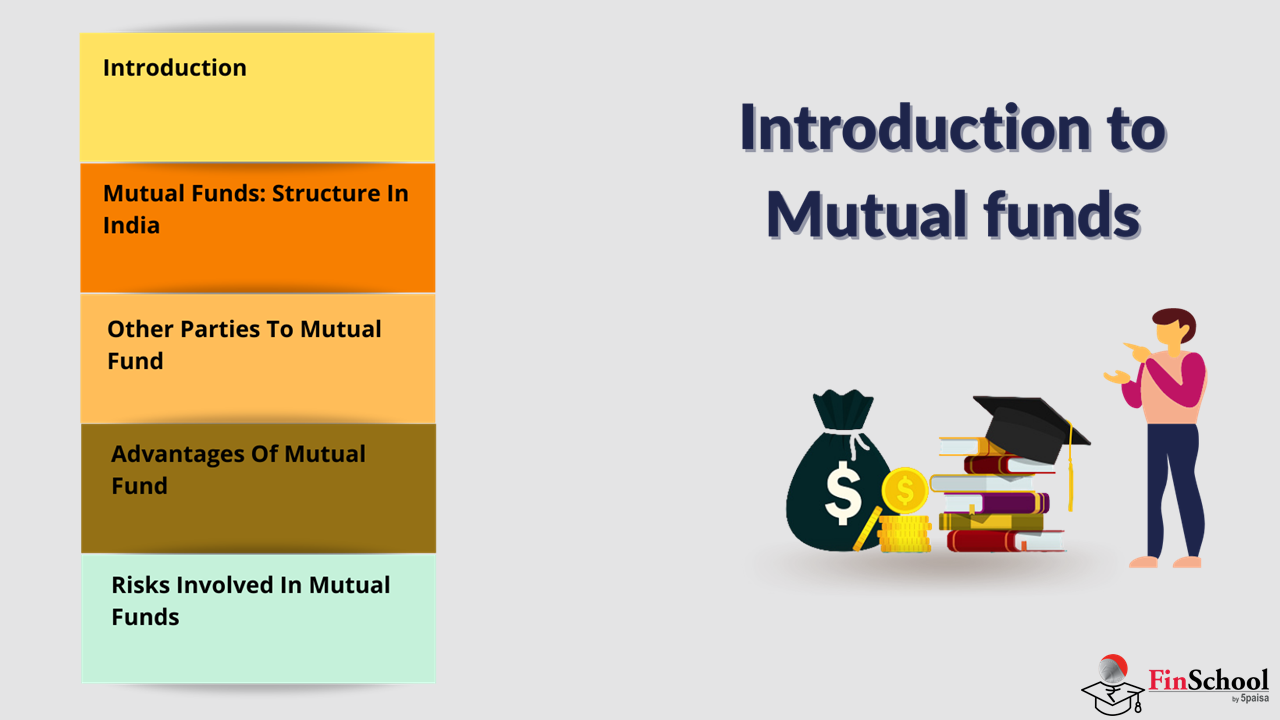- Introduction
- NFO & Offer Documents
- Learn About Classification of Mutual Funds From Mutual Fund Course
- Things To Know Before Buying MFs
- Understand Measures of Risk & Return in Mutual Fund
- What Are ETFs
- What Are Liquid Funds
- Taxation of Mutual Funds
- Mutual Fund Investment & Redemption Plan
- Regulation of Mutual Funds
- Study
- Slides
- Videos
1.1 Introduction

A Guide To Mutual Fund Fundamentals – What Is A Mutual Fund?
- A mutual fund is a financial asset that pools money from a variety of investors. The money is subsequently pooled and invested in securities such as publicly traded firms’ stocks, government bonds, corporate bonds, and money market instruments.
- You don’t own the company’s equities that mutual funds buy directly as an investor. You, on the other hand, split the profit or loss equally with the other pool investors. The term “mutual” is used to describe a mutual fund in this way.
- You benefit from the fund manager’s experience as well as the Securities Exchange and Board of India’s regulatory protection (SEBI). The expert fund manager ensures that investors receive the highest possible return.
- In other words, Mutual funds aggregate money from investors and use it to purchase other securities, most commonly stocks and bonds. The mutual fund’s worth is related to the performance of the securities it purchases. As a result, when you purchase a mutual fund unit or stock, you are purchasing the portfolio’s performance or, more specifically, a portion of the company’s equity. Investing in a mutual fund is not the same as investing in individual stocks. Unlike stock, mutual fund shares do not provide voting rights to their owners. Instead of a single holding, a mutual fund share represents investments in a variety of stocks (or other securities).
1.2 Mutual Funds : Structure In India
In India, mutual funds are organised in a three-tiered structure. It’s not just about different asset management companies or banks producing or launching a number of mutual fund schemes. There are several other participants, who play a significant role in the mutual fund mechanism. The process involves three distinct entities: the sponsor (who launches the Mutual Fund), the trustees, and the asset management organisation (which oversees the fund management). The SEBI (Securities and Exchange Board of India) Mutual Fund Rules, 1996 established the structure of Mutual Funds, which acts as a major monitor in all trades.
Structure of Mutual Fund
- Fund Sponsor
In India’s three-tier mutual fund structure, the Fund Sponsor is the first layer. According to SEBI regulations, a fund sponsor is any person or organisation that can establish a Mutual Fund for the purpose of earning money through fund management. This fund management is handled by an affiliate firm that is in charge of the fund’s investments. A sponsor can be thought of as the associate company’s publicist. A sponsor must apply to SEBI for authorisation to establish a Mutual Fund. A sponsor, on the other hand, is not permitted to work alone. A Public Trust is founded under the Indian Trust Act, 1882, and registered with SEBI once SEBI agrees to the start. Trustees are appointed when the trust has been established successfully.
Given that the sponsor is the principal entity that promotes the mutual fund and that mutual funds would regulate public funds, SEBI has established qualifying criteria for fund sponsors:
-
- The sponsor must have a minimum of five years’ experience in financial services, with a positive net worth for the past five years.
- The sponsor’s net worth from the previous year must be more than the company’s capital contribution
- The sponsor must hold a 40% stake in the asset management company’s net value in at least three of the last five years, including the current year.
- Trust & Trustees
The second tier of the structure of Mutual Funds in India is trust and trustees. Trustees, sometimes known as fund guardians, are often hired by the fund sponsor. They serve an important role in sustaining investor trust and monitoring the fund’s performance, as implied by their name.
Through a document known as a trust Deed, the fund sponsor establishes a trust in the name of the trustees. The trustees are in charge of the trust and are accountable to the investors. They are the prime stewards of funds and assets. A Trustee Company or a Board of Trustees are two options for forming Trustees. The trustees are responsible for monitoring the Mutual Fund’s operations to ensure compliance with SEBI (Mutual Fund) laws. They also keep an eye on the wealth management firm’s systems, methods, and overall operations. AMC is unable to float any scheme in the market without the approval of the trustees. The AMC’s actions must be reported to SEBI every six months by the trustees.
SEBI has also toughened disclosure regulations in order to avoid any potential conflicts of interest between the AMC and the sponsor. As a result, it is vital for trustees to operate freely and take adequate steps to protect investors’ hard-earned money. Even trustees are required to register with SEBI. Moreover, SEBI regulates their registration by cancelling or cancelling it if any of the conditions are broken.
- Asset Management Company
The trustee appoints an asset management firm (AMC). An asset management company pools funds from investors and invests them in a variety of investment possibilities, including shares, debt, real estate, gold etc
Day to day operations of asset management is handled by the AMC. It therefore arranges for the requisite offices and infrastructure, engages employees, provides for the requisite software, handles advertising and sales promotion, and interacts with regulators and various service providers
The AMC has to take all reasonable steps and exercise due diligence to ensure that the investment of funds pertaining to any scheme is not contrary to the provisions of the SEBI regulations and the trust deed. Further, it has to exercise due diligence and care in all its investment decisions.
As per SEBI regulations:
-
-
-
The directors of the asset management company need to be persons having adequate professional experience in finance and financial services related field
-
The directors as well as key personnel of the AMC should not have been found guilty of moral turpitude or convicted of any economic offence or violation of any securities laws
-
Key personnel of the AMC should not have worked for any asset management company or mutual fund or any intermediary during the period when its registration was suspended or cancelled at any time by SEBI.
-
Operations of AMCs are headed by a Managing Director, Executive Director or Chief Executive Officer.
-
Some of the other business-heads are: Chief Investment Officer (CIO), who is responsible for overall investments of the fund. Fund managers assist the CIO. As per SEBI regulations, every scheme requires a fund manager, though the same fund manager may manage multiple schemes.
-
Securities Analysts support the fund managers through their research inputs. These analysts come from two streams, Fundamental Analysis and Technical Analysis. Some mutual funds also have an economist to analyse the economy.
-
Securities Dealers help in putting the transactions through in the market. The mutual fund schemes sale and purchase of investments are executed by the dealers in the secondary market.
-
Chief Marketing Officer (CMO), who is responsible for mobilizing money under the various schemes. Direct Sales Team (who generally focus on large investors), Channel Managers (who manage the distributors) and Advertising & Sales Promotion Team support the CMO.
-
Chief Operations Officer (COO) handles all operational issues.
-
Compliance Officer needs to ensure all the legal compliances. In Offer Documents of new issues, he signs a due-diligence certificate to the effect that all regulations have been complied with, and that all the intermediaries mentioned in the offer document have the requisite statutory registrations and approvals. In order to ensure independence, the Compliance Officer reports directly to the head of the AMC. Further, he works closely with the Trustees on various compliance and regulatory issues.
-
-
1.3 Other Parties To Mutual Fund
Investors
Every investor, given his/her financial position and personal disposition, has a certain inclination to take risk. The hypothesis is that by taking an incremental risk, it would be possible for the investor to earn an incremental return. Mutual fund is a solution for investors who lack the time, the inclination or the skills to actively manage their investment risk in individual securities. They delegate this role to the mutual fund, while retaining the right and the obligation to monitor their investments in the scheme. In the absence of a mutual fund option, the money of such “passive” investors would lie either in bank deposits or other ‘safe’ investment options, thus depriving them of the possibility of earning a better return. Investing through a mutual fund would make economic sense for an investor if his/her investment, over medium to long term, fetches a return that is higher than what would otherwise have earned by investing directly.
Distributors
Distributors earn a commission for bringing investors into the schemes of a mutual fund. This commission is an expense for the scheme. Depending on the financial and physical resources at their disposal, the distributors could be:
- Tier 1 distributors who have their own or franchised network reaching out to investors all across the country; or
- Tier 2 distributors who are generally regional players with some reach within their region; or
- Tier 3 distributors who are small and marginal players with limited reach. The distributors earn a commission from the AMC.
Registrar and Transfer Agents (RTAs)
- RTAs are private companies that are registered with the Securities and Exchange Board of India (Securities and Exchange Board of India) (SEBI). They help mutual fund businesses keep track of their records. They provide investors with a single point of contact for all of their mutual fund investment information.
- Their core function is to keep track of an investor’s mutual fund operations. Buying, cashing, and switching in or out of an investment are examples of distinct forms of investor transactions. They also assist people with changing bank mandates and updating personal information. For the maintenance of investor and AMC data, RTAs are provided with professional abilities. A single entity keeps track of all of an investor’s transactions. Even if the investment was made through a number of AMCs. The majority of RTAs have a nationwide network. Their services are also accessible via the internet.
- Their network stretches across the country, and with the development of online services and online investing, you can use the RTAs’ services from anywhere.
Custodian
- A custodian, often known as a custodian bank, is a financial organisation that safeguards customers’ securities from theft or loss. Stocks and other assets may be held by the custodian in either physical or electronic form.
- They are typically large, well-known corporations tasked with safeguarding assets worth millions or billions of dollars. They provide services such as transaction settlements, account management, dividend collecting, interest payments, foreign exchange, and tax aid in addition to storing securities. The rates charged vary depending on the services requested by the clients. Some companies charge a quarterly fee based on the total value of the assets in their custody.
- No custodian in which the sponsor or its associates hold 50 percent or more of the voting rights of the share capital of the custodian or where 50 per cent or more of the directors of the custodian represent the interest of the sponsor or its associates shall act as custodian for a mutual fund constituted by the same sponsor or any of its associates or subsidiary company.
1.4 Advantages Of Mutual Fund
-
Simple Concept
The concept and management of a mutual fund investment is very simple. You choose the fund and invest in it, and the rest of the decisions will be handled by the fund managers
2. Variety of Products
The mutual fund industry offers a huge amount of schemes. They are built to cater to the different types of investors present in the market on the basis of time duration of investments, and the risk appetite of investors
3. Diversifying our Portfolios
A mutual fund is a set of different types of investment products. When we put money in a mutual fund, it automatically diversifies your portfolio.
4. Professional Fund Management
The biggest advantage of putting our money in a mutual fund comes from the professional management that our investment receives
1.5 Risks Involved In Mutual Funds
‘Mutual Funds are subjected to market risk. Read all scheme related documents carefully.’ This line is so popular. As we all have heard this in tv ads. So, what this tells us is- Yes, Mutual Funds are subjected to not only market risks but other various types of risks.
Below are some risks involved in Mutual Funds:-
- Market Risks
The most known and normal danger for any speculation vehicle is market risk. Market risk is essentially the likelihood that the market or the economy will decrease, making individual speculations lose esteem paying little heed to the exhibition.
- Inflation Risks
The danger that increasing financing costs will make your shared assets decrease in esteem. At the point when financing costs rise, security costs decrease and security common assets may likewise decay subsequently. In basic terms, if your shared assets make 10% each year and the typical cost for basic items increases 6% you are simply left with 4% as net returns from your ventures.
- Volatility Risk
The risk of losses due to the changes of prices of securities due to the change in the volatility of the market instruments. Market volatility indicates the degree of change of the price of an instrument being traded on the market.
The risk of the value of fixed-income securities going down due to a rise in the interest rates is known as the interest rate risk.












